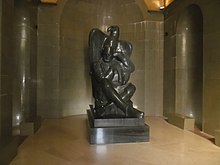Mausoleum of Njegoš
| Mausoleum of Njegoš | |
|---|---|
 | |
| Location | Mount Lovćen, Montenegro |
| Coordinates | 42°23′57″N 18°49′06″E / 42.3991°N 18.8184°E |
| Built | 1974 |
| Built for | Interring Petar II Petrović-Njegoš |
| Architect | Ivan Meštrović |

The Mausoleum of Njegoš[a] is a mausoleum interring Petar II Petrović-Njegoš located on the top of Mount Lovćen.[1]
The mausoleum is located twenty-one kilometres via asphalt road from near-by Cetinje and it was built on the idea of Croatian sculptor Ivan Meštrović. It was built on the same location of the Njegoš Testament Church which Njegoš had built in 1845 with the intention of being buried there and which he dedicated to his predecessor Petar I Petrović-Njegoš (who is canonized as Saint Peter of Cetinje in the Serbian Orthodox Church).
The church suffered damage from bombardment in both World Wars. In 1974, despite protest from the Metropolitanate of Montenegro and the Littoral and local Orthodox Christians, the old church was ordered demolished by a commission of the League of Communists of Montenegro led by Veljko Milatović and today's mausoleum was built.[1]
History
Prior to his death, Njegoš had asked to be buried atop Mount Lovćen, in a chapel dedicated to his predecessor
At the end of the
Legacy
Njegoš and his burial spot used to be mentioned in the popular Montenegrin folk song Oj, svijetla majska zoro which (with revised lyrics) has been the national anthem of Montenegro since 2004.
From 1945 to 1992, the previous Njegoš Testament Church was featured in the coat of arms of the Socialist Republic of Montenegro and from 1992 to 1994 in the coat of arms of the Republic of Montenegro.
Gallery
-
Njegos with an eagle over his head
-
Entrance to the Mausoleum
-
Caryatids at the entrance show Montenegrins
-
Jezerski vrh
-
A tunnel that leads to Jezerski vrh
-
Guvno lookout point with a view of the ″Stone Sea″
Notes
- ^ Sometimes referred to as the Njegoš Mausoleum.
References
- ^ a b Večernje novosti (2013-07-07). "Kako je srušen Njegošev zavet" (in Serbian). Retrieved 2019-08-16.
- ^ Wachtel 2004, pp. 136–39.
- ^ Wachtel 2004, pp. 143–44.
Works cited
- Books
- Wachtel, Andrew B. (2004). "How to Use a Classic: Petar Petrović-Njegoš in the Twentieth Century". In Lampe, John R.; Mazower, Mark (eds.). Ideologies and National Identities: The Case of Twentieth-Century Southeastern Europe. ISBN 978-963-9241-82-4.







